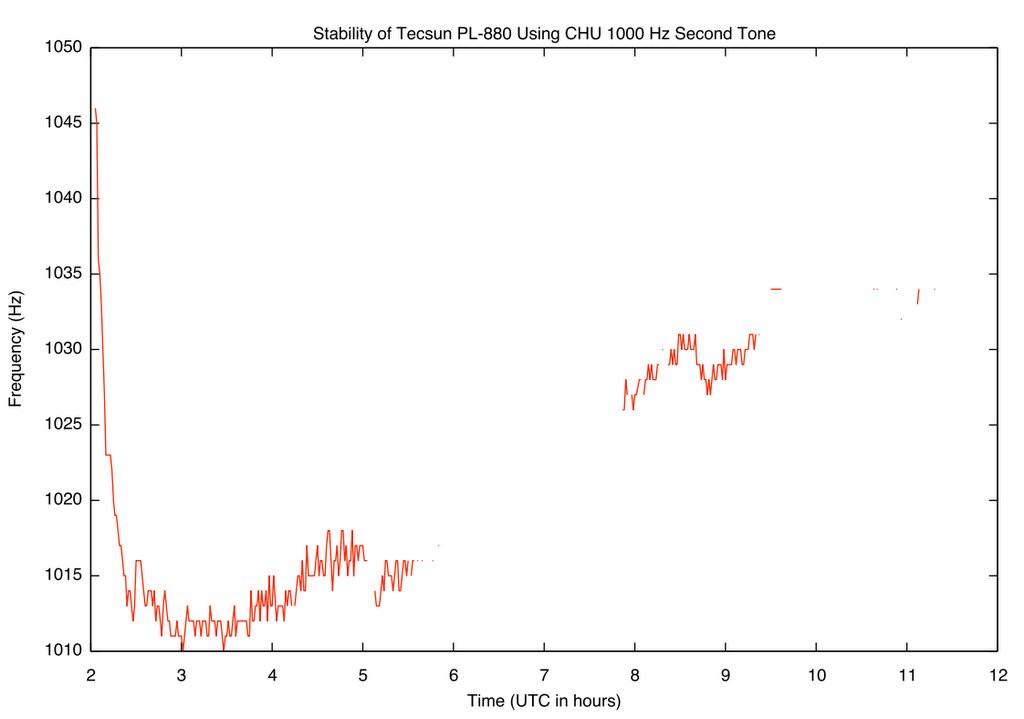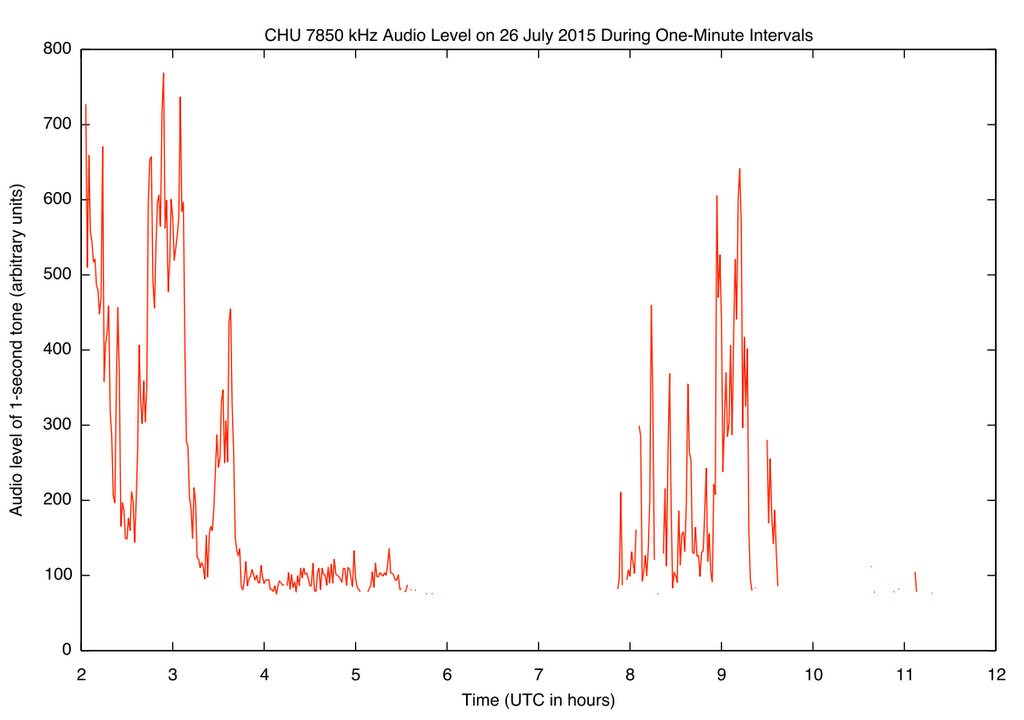 Many thanks to SWLing Post contributor, Richard Langley, for the following guest post:
Many thanks to SWLing Post contributor, Richard Langley, for the following guest post:
Frequency Stability of My Tecsun PL-880
Recently, while recording the audio on a particular SW frequency unattended over night, I decided to set my Tecsun PL-880 in USB mode with the 3.5 kHz RF bandwidth setting as I had previously noticed splatter QRM from a station 10 kHz below my frequency of interest. I adjusted the frequency to the nearest 10 Hz for natural-sounding voice. On playing the recording, I was disappointed to find that the signal had drifted in frequency and although speech was still recognizable, music was distorted.
I decided to try to measure the stability of the receiver by recording the Canadian time signal station CHU on 7850.00 kHz in USB mode (CHU has no LSB component) over night for over nine hours. The receiver was operated with just its telescopic whip antenna indoors and the audio was recorded with a Tecsun ICR-100 radio recorder / digital audio player. I wrote a Python script to compute the audio spectrum of each one-minute segment of the recorded files using a fast Fourier transform (after removing a DC component). The script then looks for the largest peaks in the spectra centred on a specified frequency and prints out the frequency (to the nearest Hz) and amplitude of the peak. In case the signal has dropped below audibility, a threshold is set and if the detected peak is below the threshold (likely just detecting the random noise background), it is skipped. The specific centre frequency I was looking for was 1000 Hz, the frequency of the tone used to mark each second of the CHU broadcast except when the voice announcement and digital signal are transmitted. In AM mode, the spectrum would consistently show a peak at 1000 Hz but in SSB mode, the peak will vary depending on the receiver frequency setting and the actual frequency of the receiver’s oscillator.
The plot below shows the received CHU one-second tone frequency as a function of time (UTC) from when the receiver was first switched on.

It shows the tone frequency started out at about 1046 Hz slowly dropping in the first half hour to about 1012 Hz and after about an hour stabilized to 1011 Hz ± 1 Hz for the better part of an hour. (This shows that you may have to allow a receiver to “warm up” for perhaps up to an hour before attempting anything close to accurate frequency reading at the order of 10 Hz.) But then, over the course of the next seven hours when the signal was audible, the frequency slowly rose ending up at about 1034 Hz. The variation might be affected by the ambient air temperature (but this should have been nearly constant), air flow around the receiver, and perhaps the charge level of the receiver’s battery. On several occasions, I have turned the receiver on (after being off for many hours) and seen a CHU frequency offset of only 10 or 20 Hz. So, I intend to repeat this experiment sometime to check on the day-to-day frequency stability. This frequency stability measurement technique could also be used with WWV/WWVH by recording the 440, 500, or 600 Hz tones broadcast at different times during the broadcast hour.
Of course, it’s also possible to check the receiver’s frequency offset in real time by switching between AM and SSB modes while adjusting the receiver frequency in 10 Hz steps until the signal sounds the same in both modes. There is also freely available computer software for various operating systems that can display a real-time spectrum of audio passed to it through a microphone or line input. So, a CHU or WWV/WWVH test using such software could also be performed in real time. And alternatively, by tuning say exactly 1 kHz away from the transmitted carrier frequency in SSB mode, the software can be used to measure the audible heterodyne frequency to better than 10 Hz — even 1 Hz. This frequency can then be added or subtracted as appropriate to the dial reading (assumed accurate or with a noted offset) to get the exact transmitted carrier frequency.
By the way, it is possible to calibrate and reset the PL-880 using the procedure documented on the SWLing Post (click here to view).
As a side benefit of the analysis I carried out, we can also look at the quality of the received signal over the recorded interval. In this case, it is a measure of the level of a particular audio frequency rather than the RF signal+noise level we usually get from the receiver S-meter or other signal strength display. This is illustrated in the plot below for the CHU recording. As you can see, reception was mostly quite good between about 02:00 and 04:00 UTC and then became fair but above threshold level until about 05:30 UTC.
The signal was then essentially inaudible up to about 08:00 UTC when with bouts of fading it became audible again for an hour or two with sunrise approaching.
— Richard Langley


My PL 660 never drifts on SSB.It’s amazing because once it’s warmed up,meaning that once Ive switched to SSB mode,the circuit takes about 3-4 mins to settle,then stays top dead center on a tuned frequency,it will stay the same all day if I leave it.But with some SSB transmitters,such as Marine,Aircraft,or even Hams,they can all be slightly off frequency.Sometimes Ive been tuned to an offical Air Craft frequency,and I’ll hear a Air Port Tower tell a plane,that they are slightly off frequency,and give them time to correct it,then continue with their flight report.But with our portables,hence Im not a SW listener,but a dedicated SSB listener,it’s most important to me,that I refine the tuning as finely as possible.So to have a radio that went off frequency over a period of time,would prove BFO drift,and probably a very poorly constructed radio.But Im most happy with all my portables including the PL660.Once it warms up in the SSB mode,it never drifts.So maybe something others can try.Once you have switched over to the SSB mode,and noticed some drift,or the BFO is either too far clockwise or anti clockwise, let it “warm up”for a few mins.Im sure it will settle down and not drift.As far as a SW station on AM goes,all types of RF conditions can cause some slight drift,otherwise the operator will need to be on hand,to correct it from time to time,but nothing to be over concerned about I think.Ive never had a problem with my Sangean 909X in this regard.